Review for No Game, No Life Collection
Introduction
Until quite recently, it might have seemed reasonable to have a joke and maybe a whinge at the constant delays No Game, No Life has seen. It was scheduled for the middle of last year as I recall, but kept getting pushed back, and pushed back. And at the last minute, when MVM realised that they could make this release special indeed, it got pushed back one final time. But who is going to turn up their nose at a collector’s edition, complete with the show on DVD, Blu-ray plus three soundtrack CDs? If your nose does turn up, you can of course wait an extra month and get the standard Blu-ray and DVD releases. You might have thought about complaining about the delays this title has seen, but February has also seen the release of Evangelion 3.33, and Mirai Nikki Part 1, both of which have had fans waiting for close to four years now. Compared to that, No Game, No Life is practically on schedule... For the purposes of this review I’m just looking at the DVD discs.
In cyberspace they are legends, the collective known as [ ] a.k.a. ‘Blank’, gamers who win at everything. Their non-names are at the top of every leader-board, and they defeat all challengers without fail, even if those challengers use hacks and cheats to try and gain an advantage. As always, real life is more boring and dispiriting. ‘Blank’ are siblings Sora and Shiro, and they are NEETs, dropouts from society who have become antisocial recluses, living only for otaku culture and playing games. This world is something that they just can’t engage with.
An enigmatic e-mail changes everything. A mysterious gamer challenges them to a game of chess, and when they win, offers them another world, a better world more suited to their talents; a world where everything revolves around games. It’s not a joke. They get transported to the world of Disboard, a fantasy world where 16 races once warred for supremacy. The god Tet tired of the bickering, and changed the rules so that conflict could only be resolved through games, and all were bound by 10 Pledges to keep the games fair. It’s Tet who’s pulled brother and sister Sora and Shiro into this world, and he sets them down in the Elkia Kingdom, the redoubt of the humans, called Imanity in Disboard. The Elkia Kingdom is a small patch of land, and Imanity are lowest ranked of the races of Disboard. They’ll have their work cut out trying to win this game. The first thing they have to do is become King, which in this country is decided by gambling, and the current heir to the throne, Stephanie Dola is a terrible gambler.
12 episodes of No Game, No Life are presented across 2 DVD discs from MVM. It’s also available on Blu-ray, and the Blu-ray DVD combo edition with the Soundtrack CDs.
Disc 1
1. Beginner
2. Challenger
3. Expert
4. Grandmaster
5. Weak Square
6. Interesting
Disc 2
7. Sacrifice
8. Fake End
9. Sky Walk
10. Blue Rose
11. Killing Giant
12. Rule Number 10
Picture
No Game, No Life gets a 1.78:1 anamorphic PAL transfer on these discs, courtesy of Hanabee in Australia. The image is relatively clear and sharp throughout, there are no visible signs of compression, and it all scales up adequately to a flat panel display. You might notice that I’m a little non-committal here, and that’s because Studio Madhouse who animated the show, have taken an unusual approach to the animation. This is a show that deliberately looks over-exposed, with oversaturated colours, and a bright warmth to the image that makes the whole show glow, to the degree that it threatens retina damage. Because of this sheer overdose of visual information, it often feels like details are lost in the brightness, buried in the afterburn. It’s the same kind of feeling I got watching J.J. Abrams Star Trek with its epic lens flares. It will be worth watching on Blu-ray to see if this is a universal phenomenon, or if it’s just an artefact of the DVD transfer.
The character designs are pretty generic, but memorable. The world design is rich and vibrant, making the most of the fantasy, and contrasting vividly with what little we see of the ‘real’ world. The animation is fluid, and accomplished with energy, it’s a show replete with in-jokes, sight gags, and pop culture references, so it’s worth keeping an eye out, and there is also more than the usual quota of fan service here.
Sound
You have the usual choice between DD 2.0 English and Japanese, with optional translated subtitles and a signs only track. As ever my preference was for the original Japanese audio, which certainly didn’t disappoint. The characters are suitably cast, and the actors give the usual, enthusiastic performances for a comedy piece. One issue might be an oddity in the subtitles. One of the characters has a habit of adding ‘desu’ to the end of her sentences. The subtitles choose to translate this as ‘thanks’ which doesn’t always make sense in the context of what she is saying. It’s a vocal affectation which isn’t easily translated (basically she’s a crude speaking girl who ends her sentences with a word of politeness). The subtitles are otherwise accurately timed and free of typos. As for the dub, it is a Sentai dub, which should be warning enough.
Extras
The discs present their content with static menus. Each episode is followed by a translated credit reel.
There are more than the usual extra features here too. No Game, No Life has character commentaries. They get the voice actors, in character to talk over the show and have some fun. They are subtitled in English and presented as follows.
Disc 1
Episode 1 has Sora, Shiro and Steph chatting, episode 4 sees Steph joined by Jibril, while episode 6 has Sora alone.
Disc 2
This also has three commentaries, with Episode 8 hosted by Tet and Izuna, episode 10 by Kurami and Fi, and episode 12 has Sora, Shiro, Steph, and her late grandfather the King, Makoto Dola.
Incidentally, save the commentaries for last, as they usually feature characters yet to be introduced in the show, and can be a bit spoilery.
As well as the commentaries, there are six No Game, No Life short animations, between two and three minutes apiece, allowing for more fan service humour with the characters, without the added burden of story narrative.
You’ll find 3 minutes of Japanese Commercials, 5 minutes of Japanese Promos, the textless credits, and trailers for Muv Luv Alternative: Total Eclipse, released in the UK by MVM, Brynhildr in the Darkness, to be released here by Animatsu, and Monthly Girls Nozaki-kun, yet to be licensed in the UK; proof positive we live in a topsy-turvy world.
Conclusion
I wasn’t expecting much from No Game, No Life. After all, anime about gamers and otaku that get sucked into a fantasy world are two a penny, especially those that get trapped in some kind of virtual hell (Log Horizon, Sword Art Online etc). Quite recently MVM brought us Outbreak Company and they’ve also been working through Familiar of Zero, both of which also saw otaku sent forth into their ideal fantasy realms, so I felt quite sated with the genre when No Game, No Life turned up for review. The first few episodes didn’t help much, as I really don’t get along with this show’s visual aesthetic. The over-exposed look, coupled with neon bright, primary colours makes my eyes hurt, and I felt that I ought to watch this show with my shades on. I really should pay more attention to the shows that MVM choose to give the Collector’s Edition treatment. They wouldn’t choose such shows at random. For No Game, No Life is really quite good indeed, once you get past the neon. In fact it might be the best of its genre.
What makes the show stand out among its peers is the focus it has on games and game playing. The protagonists, siblings Sora and Shiro might by socially excluded NEETs, unable to actually engage with society head on, but when teamed up on the Internet, they are unbeatable gamers, able to overcome any foes, even those using cheats and hacks. Shiro is the quiet, grey-haired girl anime stereotype, while Sora is outgoing and verbose, when he’s in his comfort zone, which at the start of the series is only with his sister. It’s their facility with games that catches the attention of a capricious god named Tet, and after testing them with a game of chess, he brings them to his world of Disboard, where war, conflict and killing have been done away with, and replaced with 10 rules of gaming to govern 16 contentious races. The competition for territory and power is still there, but it has to be won through games, and race champions.
The ultimate gamers are thrown into a fantasy world unrecognisable from their home, so their socially excluded tendencies aren’t provoked, and it’s a world where all is decided by gaming, their ideal world. They’re at the lowest rung of the ladder, beginners, but all they have to do is figure out the rules of the world, and to win the ultimate game, once they figure out what that is. As Sora notes, in most anime like this, the aim of the game is to figure out a way back to the real world, but in this case, why would the siblings ever want to leave?
Actually, No Game, No Life is more like a series of games within a larger game. You have 16 races vying for control of a world, with each of the races having special powers appropriate to their kind, and all bound by the Ten Pledges that govern every game, bets must be honoured, don’t be caught cheating, that kind of thing. At the start of the anime, humanity, or Imanity as they are known on Disboard, are the weakest of the sixteen, with no special powers, no magical affinity, and pretty much on the verge of extinction through continual game losses of territory, resources and power. Sora and Shiro naturally have a bias towards Imanity, and that’s where they start their rise to the top, by first winning the game to become the next king of Elkia, and regaining Imanity’s losses, then advancing up the ranks of the races.
Everything is resolved through games, whether it’s poker, or chess, or word games, up to the point where they encounter the Warbeasts and challenge them to a game, only to learn that the Warbeasts are Disboard’s technological race. They’ve created a VR game to play in a virtual world that looks just like Tokyo (provoking Sora and Shiro’s social exclusion syndrome). Of course these games don’t play out as you would expect, given the various races’ special abilities, and little tweaks to the rules. What it does mean, is that the episodes are deftly written and very well structured, the convoluted twists and turns of each game very much a key selling point to the anime, drawing the viewer in, and making them hang on every word. By the time we got to episode 9, where Sora has suddenly vanished from the world, I was sold on the series completely. It begins with only Shiro left with vague memories of his existence, and it turns out that he’s started a rather particular game, and it’s down to Shiro to confirm that her brother truly exists, figure out the rules of the game, and help him win it, all without her brother actually existing in the world. It’s a fascinating idea for an episode that the show pulls off brilliantly.
Despite the narrative brilliance, the characters themselves are rather mundane and predictable, conforming to fan expectations. This is a show that leans to the comedy side of things and maintains a healthy level of fan service throughout, with ribald humour a large aspect to its entertainment value. Communal bathing with booby gropes do ensue. The supporting cast do live up to this aspect, mostly female, and all liable to belong to Sora’s harem, if Shiro would ever let him have a harem, with most of them falling for his gaming brilliance, despite his perverted nature.
It’s fun seeing the former princess of Elkia, Steph trying to head-desk her feelings for Sora out of her skull whenever she gets too gooey-eyed over him. Kurami is the human girl who was initially trying to take over the kingdom, with the aid of her Elf sponsor Fi (Elves have magic that humans can’t detect), and when Sora and Shiro beat them anyway, they grudgingly start to turn in their favour. Then there is the Flugel Jibril, from a race of powerful and very arrogant warriors who value knowledge above all. Jibril initially doesn’t deign to notice Sora and Shiro, but when they thoroughly trounce her, she practically becomes their loyal servant. Another aspect to the humour is the otaku references; there’s plenty of nods here to other anime and manga, and the pop-culture references do tickle, as does Sora and Shiro’s tendency to revert to their social exclusion syndrome at the unlikeliest of times.
No Game, No Life’s biggest strength is in its focus on games and gaming. It results in some very well-written and fiendishly structured episodes. The humour and fan service is pretty much par for the course for such fan-favourite anime, and it’s done with pace, energy and verve, and is at least entertaining. The downside is that the show plays like a prequel series to a bigger, much longer show (of the sixteen races, Sora and Shiro have ‘conquered’ just one at the end of the series), and it very much leaves you on a promise of a season 2 and more, none of which has materialised at this point. But No Game, No Life is a great little, fun and entertaining show. If only it wasn’t so eye-bleeding ugly! Maybe it looks better in HD...




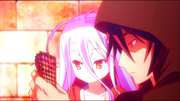

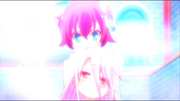
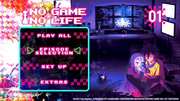
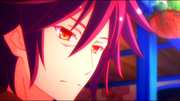
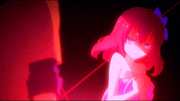
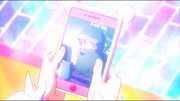



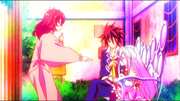
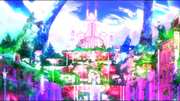
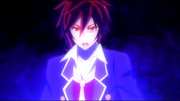
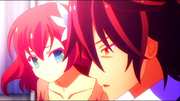
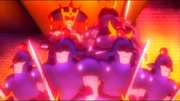
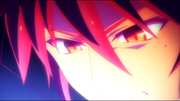
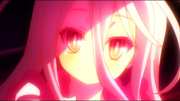
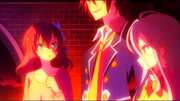

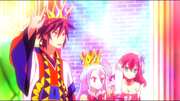


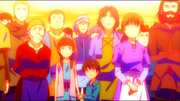

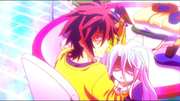





































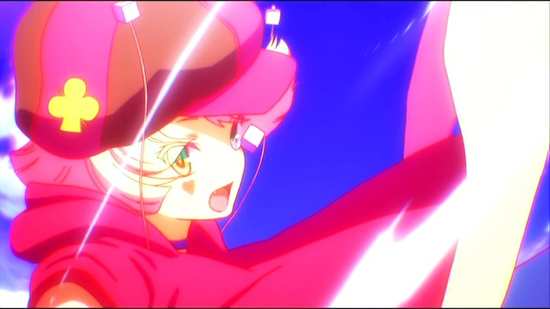









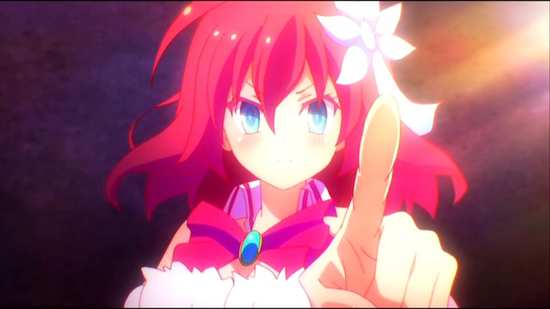

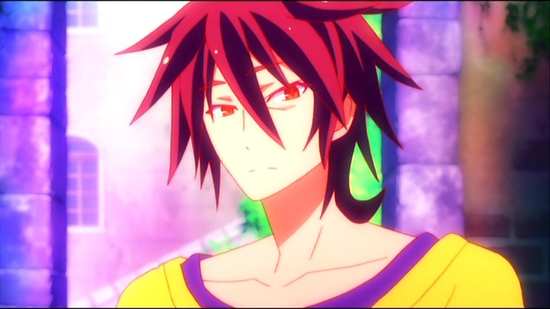

Your Opinions and Comments
Be the first to post a comment!